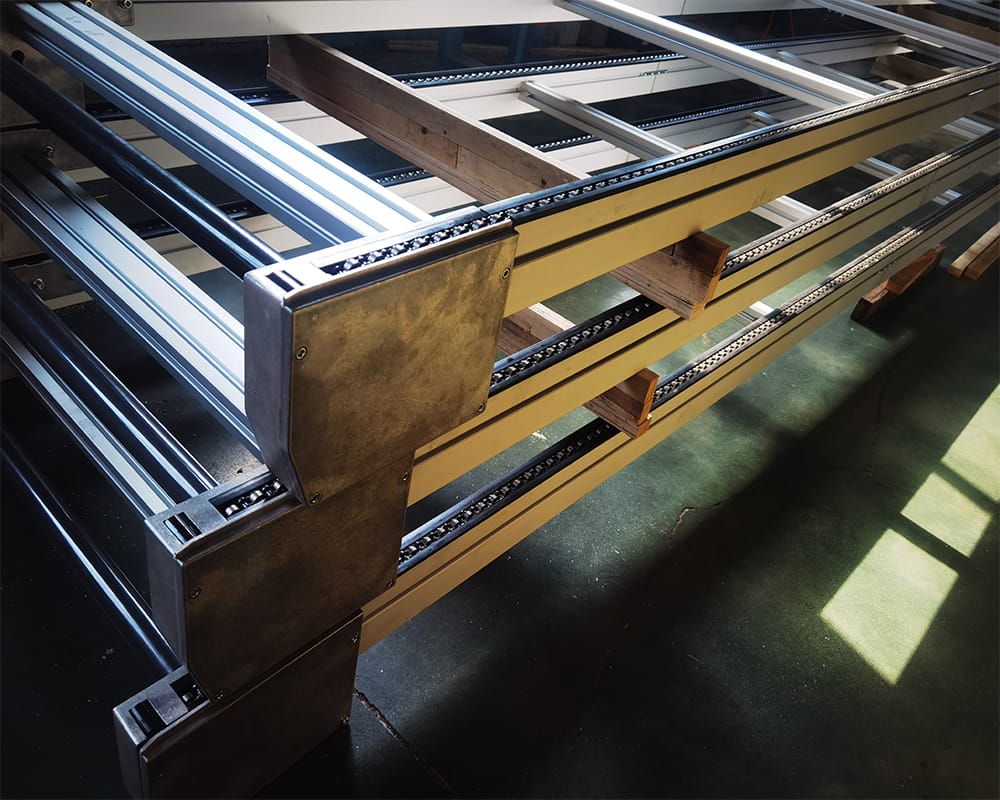Our chain conveyor is engineered for the efficient transportation of heavy and bulky materials in industrial settings. Featuring a durable chain system, it ensures smooth and reliable movement, making it ideal for handling pallets, large containers, and more.
With customizable configurations, this conveyor can be tailored to fit your specific layout and operational needs. Designed for minimal maintenance and maximum productivity, our chain conveyor is the perfect solution for optimizing your material handling processes.
Beschreibung
Toshine Heavy Duty Pallet Kettenförderer Supplier
Toshine is an industrial automation manufacturer. Toshine focuses on providing high quality, comprehensive automated and modular conveying system solutions for new energy, auto parts, 3C electronics, photostatic, logistics and other automated industrial fields, meeting the industry’s requirements for precision, Geschwindigkeit, Zuverlässigkeit, stability and other aspects needs.
Toshine main products: timing belt conveyor, ribbed belt conveyor, double speed chain conveyor, friction roller conveyor, belt conveyor, roller conveyor, mesh belt conveyor, flexible chain conveyor, as well as supporting mechanisms like lifting and transverse shifting, turnables, elevators for conveyor lines, and protective barriers system, cross-line ladders, step platforms, and other ancillary facilities.
What is a Chain Conveyor?

A chain conveyor is a type of system that uses a chain to move materials from one place to another. It’s specifically designed for transporting heavy or bulky items, making it perfect for a variety of industrial uses.
Chain conveyors can handle everything from pallets to large containers. So they can provide a reliable and efficient way to get those items where they need to go. So the chain runs along a track, ensuring smooth and steady movement.
What Are the Three Types of Conveyors?
In the industry, there are three main types of conveyors you’ll typically encounter:
**Belt Conveyors:** These use a continuous belt to carry materials and are incredibly versatile. They can transport a wide range of products, making them suitable for everything from food processing to packaging.
**Roller Conveyors:** These jobs are by using rollers to move items along a track. They can be powered by a motor or rely on gravity. You’ll often find them in warehouses and distribution centers, moving boxes and packages efficiently.
**Chain Conveyors:** As mentioned earlier, chain conveyors utilize a chain to transport materials. They excel at handling heavy or bulky items and people commonly use in manufacturing and assembly lines.
What is a Conveyor Chain Drive?
A conveyor chain drive is the mechanism that powers the chain conveyor. Typically, it consists of an electric motor connected to sprockets. When the motor runs, it turns the sprockets, which then move the chain along the conveyor track. This system keeps materials moving consistently and at the right speed. A well-designed chain drive is key to ensuring everything operates smoothly.
How to Design a Chain Conveyor
Designing a chain conveyor involves several important steps:
1. **Determine the Application:** Start by figuring out what materials you’ll be transporting, including their weight and how far they need to go. This information is important for the design.
2. **Select the Chain Type:** Choose the right type of chain for your needs. Options include roller chains, block chains, or specialized chains, depending on what you’re moving.
3. **Calculate Load Capacity:** Assess how much load the conveyor needs to handle. This helps you select the right motor and drive system to ensure everything runs smoothly.
4. **Design the Layout:** Plan the conveyor system layout, considering curves, inclines, and transfer points to make sure materials flow efficiently while saving space.
5. **Choose Components:** Select the necessary parts for your system, such as the conveyor frame, chain, and drive system, along with any extras like guides or supports.
6. **Test the System:** Once your design is ready, it’s crucial to test the conveyor system to catch any potential issues and ensure everything works well.
Benefits of Chain Conveyors
Insgesamt, chain conveyors have several key benefits. Erste, they reliably transport heavy items, making them ideal for manufacturing and logistics. Second, they generally require less maintenance than other conveyor types, which helps reduce downtime and lower maintenance costs. Therefore, they can be customizable to fit specific needs, allowing adjustments in speed, length, and layout.
Conclusion
Zusammenfassend, chain conveyors are vital in many industrial applications, especially for moving heavy or bulky items. Understanding the different types of conveyors, how conveyor chain drives work, and the design process is essential for optimizing material handling systems.
By following these steps, you can design a chain conveyor that meets your specific requirements, improving efficiency and productivity. If you have any questions about chain conveyors, feel free to reach out for expert advice!





